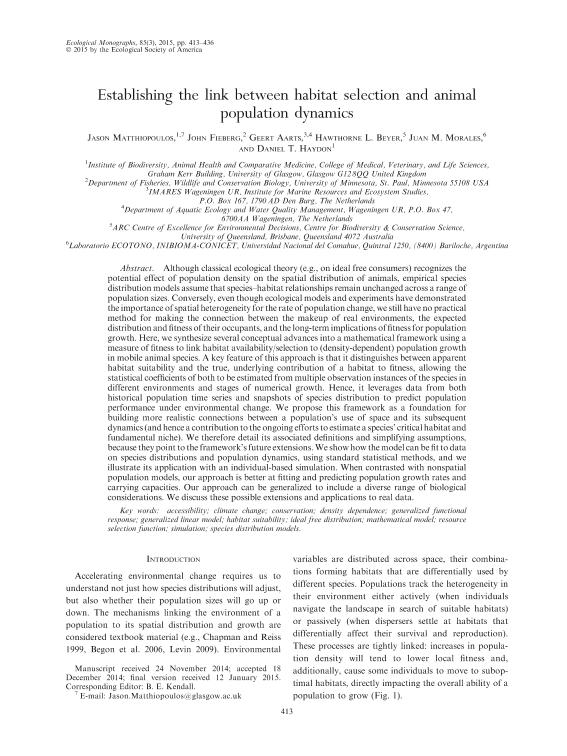Mostrar el registro sencillo del ítem
dc.contributor.author
Mathioppoulos, Jason
dc.contributor.author
Fieberg, John
dc.contributor.author
Aarts, Geert A.
dc.contributor.author
Beyer, Hawthorne L.
dc.contributor.author
Morales, Juan Manuel

dc.contributor.author
Haydon, Daniel T.
dc.date.available
2016-12-19T22:09:07Z
dc.date.issued
2015-07
dc.identifier.citation
Mathioppoulos, Jason; Fieberg, John; Aarts, Geert A.; Beyer, Hawthorne L.; Morales, Juan Manuel; et al.; Establishing the link between habitat selection and animal population dynamics; Ecological Society Of America; Ecological Monographs; 85; 3; 7-2015; 413-436
dc.identifier.issn
0012-9615
dc.identifier.uri
http://hdl.handle.net/11336/9817
dc.description.abstract
Although classical ecological theory (e.g., on ideal free consumers) recognizes the potential effect of population density on the spatial distribution of animals, empirical species distribution models assume that species–habitat relationships remain unchanged across a range of population sizes. Conversely, even though ecological models and experiments have demonstrated the importance of spatial heterogeneity for the rate of population change, we still have no practical method for making the connection between the makeup of real environments, the expected distribution and fitness of their occupants, and the long-term implications of fitness for population growth. Here, we synthesize several conceptual advances into a mathematical framework using a measure of fitness to link habitat availability/selection to (density-dependent) population growth in mobile animal species. A key feature of this approach is that it distinguishes between apparent habitat suitability and the true, underlying contribution of a habitat to fitness, allowing the statistical coefficients of both to be estimated from multiple observation instances of the species in different environments and stages of numerical growth. Hence, it leverages data from both historical population time series and snapshots of species distribution to predict population performance under environmental change. We propose this framework as a foundation for building more realistic connections between a population’s use of space and its subsequent dynamics (and hence a contribution to the ongoing efforts to estimate a species’ critical habitat and fundamental niche). We therefore detail its associated definitions and simplifying assumptions, because they point to the framework’s futu3re extensions. We show how the model can be fit to data on species distributions and population dynamics, using standard statistical methods, and we illustrate its application with an individual-based simulation. When contrasted with nonspatial population models, our approach is better at fitting and predicting population growth rates and carrying capacities. Our approach can be generalized to include a diverse range of biological considerations. We discuss these possible extensions and applications to real data.
dc.format
application/pdf
dc.language.iso
eng
dc.publisher
Ecological Society Of America
dc.rights
info:eu-repo/semantics/openAccess
dc.rights.uri
https://creativecommons.org/licenses/by-nc-sa/2.5/ar/
dc.subject
Accessibility
dc.subject
Climate Change
dc.subject
Conservation
dc.subject
Density Dependence
dc.subject
Generalized Functional Response
dc.subject
Mathematical Model
dc.subject
Resource Selection Function
dc.subject.classification
Ecología

dc.subject.classification
Ciencias Biológicas

dc.subject.classification
CIENCIAS NATURALES Y EXACTAS

dc.title
Establishing the link between habitat selection and animal population dynamics
dc.type
info:eu-repo/semantics/article
dc.type
info:ar-repo/semantics/artículo
dc.type
info:eu-repo/semantics/publishedVersion
dc.date.updated
2016-12-12T14:35:34Z
dc.journal.volume
85
dc.journal.number
3
dc.journal.pagination
413-436
dc.journal.pais
Estados Unidos

dc.description.fil
Fil: Mathioppoulos, Jason. University Of Glasgow; Reino Unido
dc.description.fil
Fil: Fieberg, John. University Of Minnesota; Estados Unidos
dc.description.fil
Fil: Aarts, Geert A.. Institute for Marine Resources and Ecosystem Studies; Países Bajos. Department of Aquatic Ecology and Water Quality Management; Países Bajos
dc.description.fil
Fil: Beyer, Hawthorne L.. The University Of Queensland; Australia
dc.description.fil
Fil: Morales, Juan Manuel. Universidad Nacional del Comahue. Centro Regional Universitario Bariloche. Laboratorio de Ecotono; Argentina. Consejo Nacional de Investigaciones Científicas y Técnicas. Centro Científico Tecnológico Patagonia Norte. Instituto de Investigación en Biodiversidad y Medioambiente; Argentina
dc.description.fil
Fil: Haydon, Daniel T.. University Of Glasgow; Reino Unido
dc.journal.title
Ecological Monographs
dc.relation.alternativeid
info:eu-repo/semantics/altIdentifier/url/http://onlinelibrary.wiley.com/doi/10.1890/14-2244.1/full
dc.relation.alternativeid
info:eu-repo/semantics/altIdentifier/url/https://doi.org/10.1890/14-2244.1
Archivos asociados
